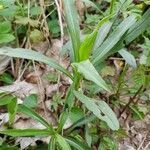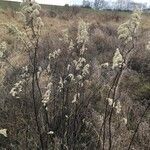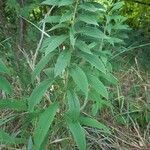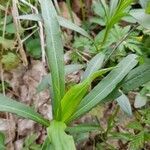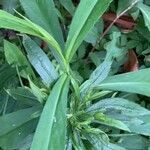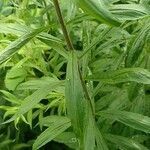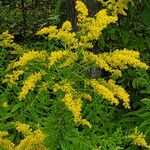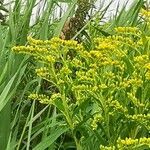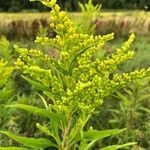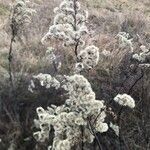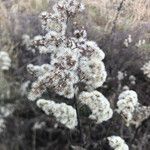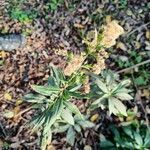Plants 50–200 cm (solitary or clustered); rhizomes short-to long-creeping. Stems 1–20+ or clustered, erect, glabrous or sparsely strigose in arrays, sometimes glaucous. Leaves: basal 0; proximal cauline usually withering by flowering time, sessile, lanceolate, 91–97 × 10–14 mm, margins sharply serrate, 3-nerved, apices acuminate, abaxial faces pilose on nerves or glabrous; mid to distal cauline similar, 57–76 × 0.7–1.2 cm, largest toward mid stem, decreasing distally. Heads 40–600 , secund, in broadly secund, pyramidal paniculiform arrays, rarely rhombic or club-shaped, proximal branches divergent, recurved, glabrous-glabrate or strigose, sometimes glaucous. Peduncles 1.5–3 mm, sparsely to densely strigillose; bracteoles 0–2, linear-lanceolate. Involucres campanulate, (2–)2.5–4(–5) mm. Phyllaries in 3–4 series, unequal, acute; outer lanceolate, inner linear-lanceolate (hexa-ploids from far west can have minute stipitate glands, especially near base of outer phyllaries and peduncle bracts). Ray florets (7–)9–15(–24) (conspicuous); laminae 1–3 × (0.1–)0.2–0.4 mm. Disc florets (4–)7–12(–17); corollas (2.5–)3–3.5(–4.5) mm, lobes 0.6–1(–1.4) mm. Cypselae 1.3–1.5 mm, sparsely strigose; pappi 2–2.5 mm. 2n =18, 36, 54.
More
Similar to no. 40 [Solidago canadensis L.], but puberulent only in the infl, the stem glaucous; lvs glabrous or with a line of hairs along the 3 main veins beneath, the larger ones 6–17 × 1–4.5 cm; infl paniculiform, with recurved-secund branches; invol 2.5–4 mm, its bracts mostly firmer, blunter, and greener than in no. 40; rays (8–)10–17; disk-fls 6–12; 2n=18, 36, 54. Moist open places; N.S. and Que. to Ga., w. to B.C. and N.M. (S. serotina)
An erect herb. The stems are bluish-green. They grow 50 cm to 2 m tall. The leaves are near the base and are long ans sword shaped. The flowers are yellow in flat topped flower arrangements that curve over.
Low wet areas, roadsides, pond margins and the sides of streams, generally in mesic areas.
More
It is a temperate plant. It grows in moist open thickets.
